
Unlocking the Secrets to a Thriving Garden: Essential Tips for Every Gardener
Gardening is more than just a hobby; it’s a way to connect with nature, grow your own food, and beautify your environment. Whether you are a novice gardener or a seasoned green thumb, the 10 Biggest Time-Saving Gardening Hacks from recent discussions highlight some innovative strategies that can help streamline your gardening experience. As we delve deeper, let’s explore practical tips and insights that can elevate your gardening game.
In '10 Biggest Time-Saving Gardening Hacks,' the discussion dives into effective strategies for efficient gardening, sparking deeper analysis on practical tips for enhancing garden productivity.
Understanding Garden Labels: What Do They Really Mean?
When you step into a nursery, you’ll notice numerous labels on plants detailing their sunlight needs, watering requirements, and growth potential. These labels serve as a fantastic launching point for every gardener. Knowing the essentials, such as which plants thrive in full sun versus partial shade, can save you time and frustration in the long run. By paying attention to these details, you not only ensure that your plants flourish but also prevent the common pitfalls of planting in the wrong conditions.
The Importance of Composting: Eco-Friendly Gardening
Composting is a game-changer for both the environment and your garden. Not only does it reduce kitchen waste, but it also enriches your soil with vital nutrients. Setting up a compost bin should be a priority for any eco-conscious gardener. Just remember to balance your greens—kitchen scraps and grass clippings—with browns, like dried leaves and twigs. Avoid adding items like bread and meat, which can attract pests. With patience, your compost can create vibrant soil that supports diverse plant growth over time.
Choosing the Right Irrigation System: Smart Water Management
With unpredictable weather patterns, investing in an efficient irrigation system has become essential. Transitioning to smart controllers can optimize your watering schedule. By syncing these systems with weather forecasts, you can conserve water effectively. Additionally, rainwater tanks can provide a sustainable solution, allowing you to utilize rainfall to hydrate your vegetable garden during drier days.
Perfecting Your Soil Health for Optimal Growth
The foundation of a successful garden is undoubtedly healthy soil. Regularly enrich your soil with organic compost and adjust its composition based on the specific plants you are cultivating. Utilizing soil testing kits can reveal the pH and nutrient levels, guiding you to make informed amendments. Always remember: healthy soil leads to thriving plants.
Planting the Right Veggies: What to Grow for Your Needs
Not every gardener has the space to cultivate a wide variety of vegetables. It’s essential to select crops that suit your lifestyle and dining habits. For example, growing leafy greens such as lettuce allows you to harvest exactly what you need and minimize waste. Similarly, herbs in pots offer both convenience and flavor, and you can reposition them in sunlight as required.
Mulching: The Unsung Hero of Plant Care
Applying mulch is an often-overlooked step that can bring a multitude of benefits to your garden. Not only does it suppress weeds, but it also retains soil moisture and regulates temperature for your plants. Different types of mulch serve various purposes, so choose wisely: use coarser mulch for decorative areas and finer mulch for vegetable patches to boost nutrient retention.
Creating an Eco-Friendly and Stylish Garden Design
Your garden doesn’t have to sacrifice aesthetics for sustainability. Integrate flowering plants alongside edible crops to create a visually appealing design that also attracts beneficial pollinators. Companion planting, where you grow certain plants together for mutual benefits, can enhance biodiversity while adding beauty to your space.
Gardening with Kids: Fostering a Love for Nature
Getting children involved in gardening can ignite their curiosity and appreciation for nature. Simple tasks like planting seeds, watering plants, or even composting can provide fulfilling experiences. Watching plants grow nurtures a sense of responsibility and connection, fostering future generations of environmental stewards.
Final Thoughts: Enjoy the Journey of Gardening
Spring is upon us, offering the perfect time to rejuvenate your garden. There’s no better feeling than stepping into your green sanctuary and admiring the fruits of your labor. By adopting these time-saving gardening hacks, you’ll soon find that your garden maintenance becomes less of a chore and more of a cherished ritual. Remember, the best gardens are a product of patience, care, and a little creativity. So, roll up your sleeves, get outside, and transform your outdoor space into the haven you've always wanted.
 Add Row
Add Row  Add
Add 




Write A Comment